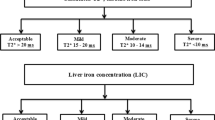Abstract
Introduction b-Thalassemia major (TM) and thalassemia intermedia (TI) are forms of inherited hemoglobinopathies. Our aim was to evaluate a population of asymptomatic TM and TI patients using cardiovascular magnetic resonance (CMR). We hypothesized that the TI group could be differentiated from the TM group based on T2*. We also hypothesized that the TI group would demonstrate significantly higher cardiac output compared to the TM group. Patients and methods Twenty-one consecutive TI patients aged 23(19–25) years, 21 TM patients and 21 age and sex matched controls were studied. Evaluation of heart, liver T2* relaxation time and right and left ventricular parameters was performed using a 1.5 T system. Results Myocardial and liver T2* values were significantly higher in TI patients compared to TM (34.35 ± 2.36 vs 15.77 ± 3.53 m, P < 0.001 and 5.12 ± 6.52 vs 1.36 ± 0.53 ms, P < 0.001, respectively). Controls had myocardial T2* 35.07 ± 4.52 ms (similar to TI patients, but significantly increased compared to TM patients, P < 0.001) and liver T2* 26.28 ± 2.37 ms (significantly increased compared to both TI and TM patients, P < 0.001). Left ventricular end-diastolic (LVEDV), end-systolic (LVESV) volumes and left ventricular ejection fraction (LVEF) were higher in TI patients compared to TM (P < 0.001). Stroke volume (LVSV), cardiac output (LVCO) and cardiac index (LVCI) were similarly increased in TI patients compared to TM (P < 0.001). Right ventricular end-diastolic volume (RVEDV), right ventricular end-systolic volume (RVESV) and right ventricular ejection fraction (RVEF) were higher in TI patients compared to TM (P < 0.001). Conclusions Although in TM iron plays a crucial role in the evolution of the disease, in TI the high output cardiac state seems to be the most prominent finding.

Similar content being viewed by others
Abbreviations
- TI:
-
Thalassemia Intermedia
- TM:
-
Thalassemia Major
- T2*liver:
-
T2*relaxation time of liver
- T2*heart:
-
T2*relaxation time of heart
- BSA:
-
Body surface area
- LVEDV:
-
Left ventricular end-diastolic volume
- LVESV:
-
Left ventricular end- systolic volume
- LVEF:
-
Left ventricular ejection fraction
- LVSV:
-
Left ventricular stroke volume
- LVCO:
-
Left ventricular cardiac output
- LVCI:
-
Left ventricular cardiac index
- RVEDV:
-
Right ventricular end-diastolic volume
- RVESV:
-
Right ventricular end-systolic volume
- RVEF:
-
Right ventricular ejection fraction
References
Modell B, Berdoukas V (1984) The clinical approach to thalassemia. Grune &Stratton, New York, NY
Zurlo MG, De Stefano P, Borgna-pignatti C (1989) Survival and causes of death in thalassemia major. Lancet 2:27–30. doi:10.1016/S0140-6736(89)90264-X
Aesopos A, Farmakis D, Karagiorga M et al (2001) Cardiac involvement in thalasemia intermedia: a multicenter study. Blood 97:3411–3416. doi:10.1182/blood.V97.11.3411
Buja LM, Roberts WC (1971) Iron in the heart: etiology and clinical significance. Am J Med 51:209–221. doi:10.1016/0002-9343(71)90240-3
Engle MA (1969) Cardiac involvement in Cooley’s anemia. Ann N Y Acad Sci 119:694–702. doi:10.1111/j.1749-6632.1965.tb54070.x
Jacobs A (1980) The pathology of iron overload. In: Jacobs A, Worwood M (eds) Iron in biochemistry and medicine, II. Academic Press, New York, pp 439–452
Jacobs A, Miller F, Worwood M, Beamisch R et al (1972) Ferritin in the serum of normal subjects with iron deficiency and iron overload. BMJ 4(5834):206–211
Crosby WH (1976) Serum ferritin fails to indicate hemochromatosis: nothing gold can stay. N Engl J Med 294:333–334
Barry M, Sherlock S (1971) Measurement of liver iron concentration in liver biopsy specimens. Lancet 1:100–103. doi:10.1016/S0140-6736(71)90838-5
Brittenham GM, Badman DG (2003) Noninvasive measurement of iron: report of an NIDDK workshop. Blood 101:15–19. doi:10.1182/blood-2002-06-1723
Liu P, Henkelman M, Joshi J et al (1996) Quantification of cardiac and tissue iron by nuclear magnetic resonance relaxometry in a novel murine thalassemia-cardiac iron overload model. Can J Cardiol 12:155–164
Mavrogeni S, Maris T, Gouliamos T et al (1998) Myocardial Iron deposition in b-thalassemia studied by magnetic resonance imaging. Int J Card Imaging 14:117–122. doi:10.1023/A:1005922016048
McKee PA, Castelli WP, McNamara PM et al (1971) The natural history of congestive heart failure, the Framingham Study. N Engl J Med 285:1441–1446
Olivieri NF, Nathan DG, MacMillan JH et al (1994) Survival in medically treated patients with homozygous b-thalassemia. N Engl J Med 331:574–578. doi:10.1056/NEJM199409013310903
Anderson LJ, Holden S, Davis B et al (2001) Cardiovascular T2* magnetic resonance for the early diagnosis of myocardial iron overload. Eur Heart J 22:2171–2179. doi:10.1053/euhj.2001.2822
Wood JC, Enriquez C, Ghugre N et al (2005) MRI R2 and R2* mapping accurately estimates hepatic iron concentration in transfusion-dependent thalassemia and sickle cell disease patients. Blood 106:1460–1465. doi:10.1182/blood-2004-10-3982
Mavrogeni S, Markussis V, Kaklamanis L et al (2005) A comparison of magnetic resonance imaging and cardiac biopsy in the evaluation of heart iron overload in patients with b-thalassemia major. Eur J Haematol 75:241–247. doi:10.1111/j.1600-0609.2005.00474.x
Lorenz CH, Walker ES, Morgan VL, Klein SS, Graham TP Jr (1999) Normal human right and left ventricular mass, systolic function, and gender differences by cine magnetic resonance imaging. J Cardiovasc Magn Reson 1:7–21. doi:10.3109/10976649909080829
Stark DD, Moseley ME, Bacon BR et al (1995) Magnetic resonance imaging and spectroscopy of hepatic iron overload. Radiology 154:137–142
Voskaridou E, Douskou M, Terpos E et al (2004) Magnetic resonante imaging in the evaluation of iron overload in patients with beta thalassaemia and sickle cell disease. Br J Haematol 126(5):736–742. doi:10.1111/j.1365-2141.2004.05104.x
Author information
Authors and Affiliations
Corresponding author
Rights and permissions
About this article
Cite this article
Mavrogeni, S., Gotsis, E., Ladis, V. et al. Magnetic resonance evaluation of liver and myocardial iron deposition in thalassemia intermedia and b-thalassemia major. Int J Cardiovasc Imaging 24, 849–854 (2008). https://doi.org/10.1007/s10554-008-9332-2
Received:
Accepted:
Published:
Issue Date:
DOI: https://doi.org/10.1007/s10554-008-9332-2




